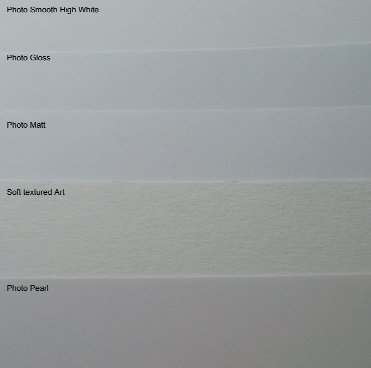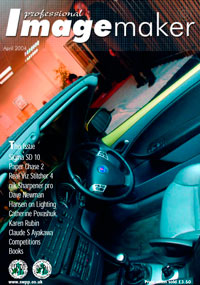articles/Paper/impartimage-page1
Paper Chase - Impart Image Impact - part 1 of 1 2 3
by Mike McNamee Published 01/04/2004
This issue, Paper Chase moves to the English Lake District to review a product line from the old established firm of James Cropper.They have taken their existing knowledge of fine board making and applied modern coatings for ink jet use.With the brand names Impart, Impact and Image, many of the finishes are available as 1.3mm board, providing a bonus for the busy studio as they can be inserted straight into the frame without further finishing operations.
PAPERMILLDIRECT is a new online purchasing organisation selling the media from James Cropper plc from the English Lake District. (see call out box). Croppers have a long standing tradition in paper conversion and have always had a considerable expertise in board making .They have now combined this skill to provide an range of papers and boards for the Giclee, photography and enthusiast markets. It was the board, which was initially brought to our attention, but here we look at both the Giclee and photography products. The board is coated with the identical finish to the paper products but bulked up to 1.3mm thickness. This has huge workflow advantages for the busy professional, as the image can be place directly into the frame. The range is sold under the names Impart, Image and Impact with target markets of fine art, professional photography and enthusiast respectively. The Impact range has the same quality of coating but onto generally thinner substrates. We chose to review only the Impart and Image ranges.

Impart - the giclee range
For the initial trials, profiles were not available for the Epson Ultrachrome ink set for the 2100, 4000, 7600 or 9600 using either Matte or photo Blacks. For this reason we picked a profile from our files for a paper we felt was the most similar - a fine art, lightly textured 100% cotton rag without optical brighteners. With luck (or was it skill?) we found a near perfect match. The moral is that if you are already running prints with this type of media you can retain the same setting and profiles with a reasonable degree of confidence.
Colormetric data on the two giclee materials was close enough to be called identical. The average colour errors across the gamut were about 6 Lab Delta E. The borrowed profile mapped the neutrals to the same base paper tone and so everything looked fine and dandy. The metameric index for both materials was low at 2.2 (Lab Delta E; D65 to Tungsten on the mid grey). The colour audit was carried out after 1 hour and 24 hours. The paper did dry down by a very tiny amount but not enough for the eye to detect (2/100ths of a percentage point over the gamut). In practice the print is dry as it leaves the printer.
Impart Soft Textured Art - 315gsm and 1.3mm
This is a cream finish, very slightly textured, typical of a mould made media. It is 100% cotton rag, finished to archival standards and complying with Fine Art Trade Guild requirements. The high reflectance is achieved through the use of premium products in the manufacture and does not rely on optical brighteners. There was absolutely no lift in the spectral trace at the blue wavelengths and the paper was totally inert in ultraviolet light (see image). The coating held a maximum black of a little over 19%, good for this class of product. Differentiation of the deep blacks was maintained down to 15 RGB points, again good for this class of product as they sometimes clog the shadows. The sideways spread of the ink (dot gain in prepress terminology) was enough to almost eradicate the printer head pattern but not enough to deteriorate the fine detail in text. The grey scale linearity was good with a smooth transition into the maximum density of 1.55 (Dmax) - again typical of this class of product. The colour accuracy using the "off the shelf" profile was good, it lay in the upper error band of the bespoke profiled data on our data base and would probably improve with a bespoke profile. The light flesh tones were very accurate, slightly desaturated in the richer flesh tones and slightly rotated towards yellow in the very pale flesh tones. The average flesh tone error was 2.1 DE2000 and the error in the Macbeth Light Flesh tone was a minuscule 0.7 units. As with all the "cream" base tone fine art materials, these flesh tones are extremely accurate.
Impart PhotoSmooth High White Cotton
This paper has a slight lift in its spectral trace in the blue region. It is the closest to neutral of all the range although it was not totally inert to uv light. Its overall colourimetric data was so close to its sibling, Soft Texture Art, that they can be regarded as identical.
As the name implies, this is a smoother, more calendered finish and the lack of surface undulations displays finest detail slightly better. It might therefore be regarded as being more suitable for the reproduction of photographs as fine art. In truth you can take your choice on aesthetics alone!
Giclee Varnishing
We gave both the Impart materials a coat of DCP Giclee varnish and discovered quite a difference. As expected the Dmax was raised. However the Soft Textured Art media deepened to a greater extent reaching a Dmax of 1.94 compared to 1.75 for the Photo Smooth. In addition there was some drag out of the pigment from the Photo Smooth, smearing a dark tone onto the surrounding border. It might be possible to prevent this with a quick sizing coat of varnish using a roller but time did not allow this experiment. For the present it seems that water based varnish is only possible on the Soft Textured Art media.
One other slight problem we had was there was some dust and fibres on the surface which blocked the ink spray and then fell off to leave a "hole" in the image.This is quite normal with the thicker board materials where there is a lot more cutting dust/fibres and you are advised to brush down the board with a clean brush before you print.
You are currently on page 1
- Paper Chase - Impart Image Impact page 1
- Paper Chase - Impart Image Impact page 2
- Paper Chase - Impart Image Impact page 3
1st Published 01/04/2004
last update 09/12/2022 14:55:11
More Paper Articles
There are 0 days to get ready for The Society of Photographers Convention and Trade Show at The Novotel London West, Hammersmith ...
which starts on Wednesday 15th January 2025





